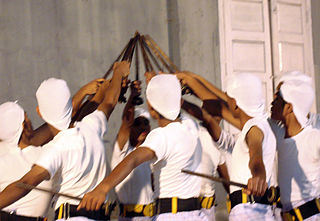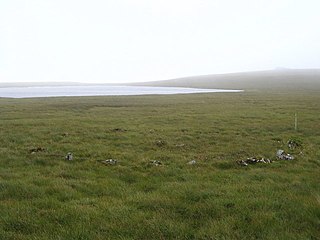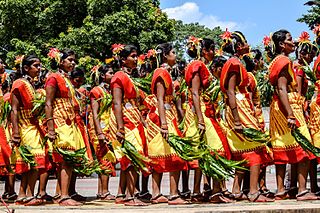
Giddha is a popular folk dance of women in the Punjab region. The dance is often considered derived from the ancient dance known as the ring dance and is just as energetic as bhangra; at the same time it manages to creatively display feminine grace, elegance and flexibility. It is a highly colourful dance form which has spread to all regions of India. Women perform this dance mainly at festive or social occasions. The dance is accompanied by rhythmic clapping, with a typical traditional folk song performed by elder women in the background.

Kolkali is a folk art performed in Malabar region of Kerala, India. The dance performers move in a circle, striking small sticks and keeping rhythm with special steps. The circle expands and contracts as the dance progress. The accompanying music gradually rises in pitch and the dance reaches its climax. Kolkali is now a popular event in Kerala School Kalolsavam, which is considered as the biggest cultural event of Asia. There are two styles of Kolkali: the actual Kolkali and Thekkan Koladi. The actual Kolkali consists of Thacholikali, Rajasooyam etc. The actual kolkali is almost at verge of extinction and Thekkan Koladi is still alive as it is added in state kololsavams.

Kurdish dances are a group of traditional dances among Kurds. It is a form of a circle dance, with a single or a couple of figure dancers often added to the geometrical center of the dancing circle. At times musicians playing on a drum or a double reed wind instrument known as a zurna, accompany the dancers. Often there are dancers twirling handkerchiefs who lead the half-circled group of dancers. The dancers, generally the females, but also, on occasions, the males, wear traditional Kurdish clothes. The Kurds dance on several occasions such as Kurdish festivals, birthdays, New Years, Newroz, marriage and other ceremonies and the dances have several names which often relate to local names and traditions. Its noteworthy that these folkloric dances are mixed-gender which distinguishes the Kurds from other neighbouring Muslim populations. On March 3, 2023, Iranian police shut down a sports centre over mixed-gender Kurdish dances.
The hivinau is a dance from Tahiti where the dancers turn in pairs around the orchestra. It is often either the first or the last dance of a dance festival or used as a transition between two dances.
The pāʻōʻā, is a modern dance from Tahiti where the dancers sit on their knees in a circle on the ground, sing and tap with their hands on their thighs on the rhythm of the music, which is a quite repetitive scanning refrain. Selected members, one boy and one girl, dance inside the circle. The whole scenario has something of a rooster fight. Coincidentally the theme of the dance is usually from the hunt or from fishing.

Fourna is a village and a former municipality in Evrytania in central Greece. Since the 2011 local government reform it is part of the municipality Karpenisi, of which it is a municipal unit. The municipal unit has an area of 132.232 km2. The population of the municipal unit is 589. The municipal unit consists of the villages Fourna, Vracha, and Kleisto.
Greek dance is an old tradition, being referred to by authors such as Plato, Aristotle, Plutarch and Lucian. There are different styles and interpretations from all of the islands and surrounding mainland areas. Each region formed its own choreography and style to fit in with their own ways. For example, island dances have more of a different smooth flow to them, while Pontic dancing closer to the Black Sea, is very sharp. There are over 10,000 traditional dances that come from all regions of Greece. There are also pan-Hellenic dances, which have been adopted throughout the Greek world. These include specifically the Syrtos, Kalamatianos, Pyrrhichios, Ballos, Zeibekiko, and hasapiko.
The corridinho is a form of Portuguese folk dance, namely in the Algarve region. The origin of the dance itself is unclear and believed older, although it gained popularity in the 1800s. The name derives from correr, to run which partly describes this type of dance. The dance was performed in a round in the open air. The oldest musical instruments recorded were small flutes or fifes (pífaro) and harmonicas, (harmónica) until the accordion was implemented and dominated ever since.
Kummi is a folk dance, popular in Tamil Nadu and Kerala in India, danced mostly by South Indian women in circle. Dancing may be different. In some places, it is very simple, with rhythmic clapping or beating of the drums. In other places dancers imitate various harvesting activities. Kummi often accompany by songs, called "Kummi songs". It is often danced during festivals. It is also danced by Tamils of Sri Lanka. Kummi songs became a popular addition to kuthiyottam festivities in modern times.

Breakin’ Convention is an international hip-hop theatre festival based in London, England that was founded in 2004 and is produced annually by Sadler's Wells theatre. It has been under the artistic direction of playwright and dancer Jonzi D since its inception. Since May 2008 Breakin’ Convention has expanded its activity beyond the three-day festival to include tours across the UK, developing new theatre work with local hip-hop artists, and to produce year-round professional development courses for UK-based hip-hop choreographers, artists, and dance/theatre companies.
The Diplos Horos is a dance from Messenia in the Peloponnese, Greece. It is a dance where the dancers form a single circle formation into a double via the hand hold. The dance is a simple sta tria in formation but is accompanied by the song Διπλό Χορό Χορεύουμε, Διπλά Τραγούδια Λέμε.

Haltadans, also known as Fairy Ring or Haltadans stone circle, is a stone circle on the island of Fetlar in Shetland, Scotland. This site is a ring of 38 stones, of which 22 are still fixed in the soil, and it is 11 metres (37 ft) in diameter. Inside this is an earthen ring 7.9 metres (26 ft) in diameter, with a 1.5 metres (5 ft) gap in the southwest side. In the center of the rings are two rectangular pillars.
Music of Thessaly is the music of the geographic and historical region of Thessaly in Greece. Folk dances from Thessaly are slow and stately, however the music accompanying the Syrtos dance, is typically livelier and more energetic than it is in other parts of Greece and include: Kalamatianos, Thessalikos, Dionysiakos, koftos, Sirtaki, Kalamatiano, Syrtos, kleistos, kangeli, gaitanaki, tsamikos, Pilioritikos, Svarniara, Sta tria, Karagouna, Kleistos, zeibekiko, Rougatsiarikos, Tsamiko of Deskati, antikrystos and galanogalani.
Pidikhtos, is a Greek folk dance with Cretan origin, dancing in a circle formation. It is very widespread in Crete and the Greek islands.
Gaitanaki is a form of a Greek folk dance from Thessaly, Greece. It is a circle dance. It is also very widespread in Epirus.

Karma dance or Karma Naach is a traditional dance of central and Eastern India annually performed during the karma festival. Karma is a famous autumnal festival, it starts from the 11th day of the bright fortnight of the month of Bhadrab. It is performed in State of Chhattisgarh, Jharkhand, Madhya Pradesh, Odisha and West Bengal. Karma means 'fate'.
Kechagiadikos is a circle dance done on the Island of Lemnos in Greece. The dance is done free hold and moves in a circle. Both men and women dance to the song 'Βρε Κεχαγιά Περήφανε' "Vre Kehagia Perifane'. The word Kehagia (Κεχαγιάς) comes from the Turkish word Kahya, meaning housekeeper.

Lavrio Indoor Hall, or Kleisto Gymnastirio Lavriou, is an indoor sporting arena that is located in the city of Lavrio, Attica, Greece. The seating capacity of the arena for basketball games is 1,700 people. The arena is owned by the municipality of Lavreotiki.







